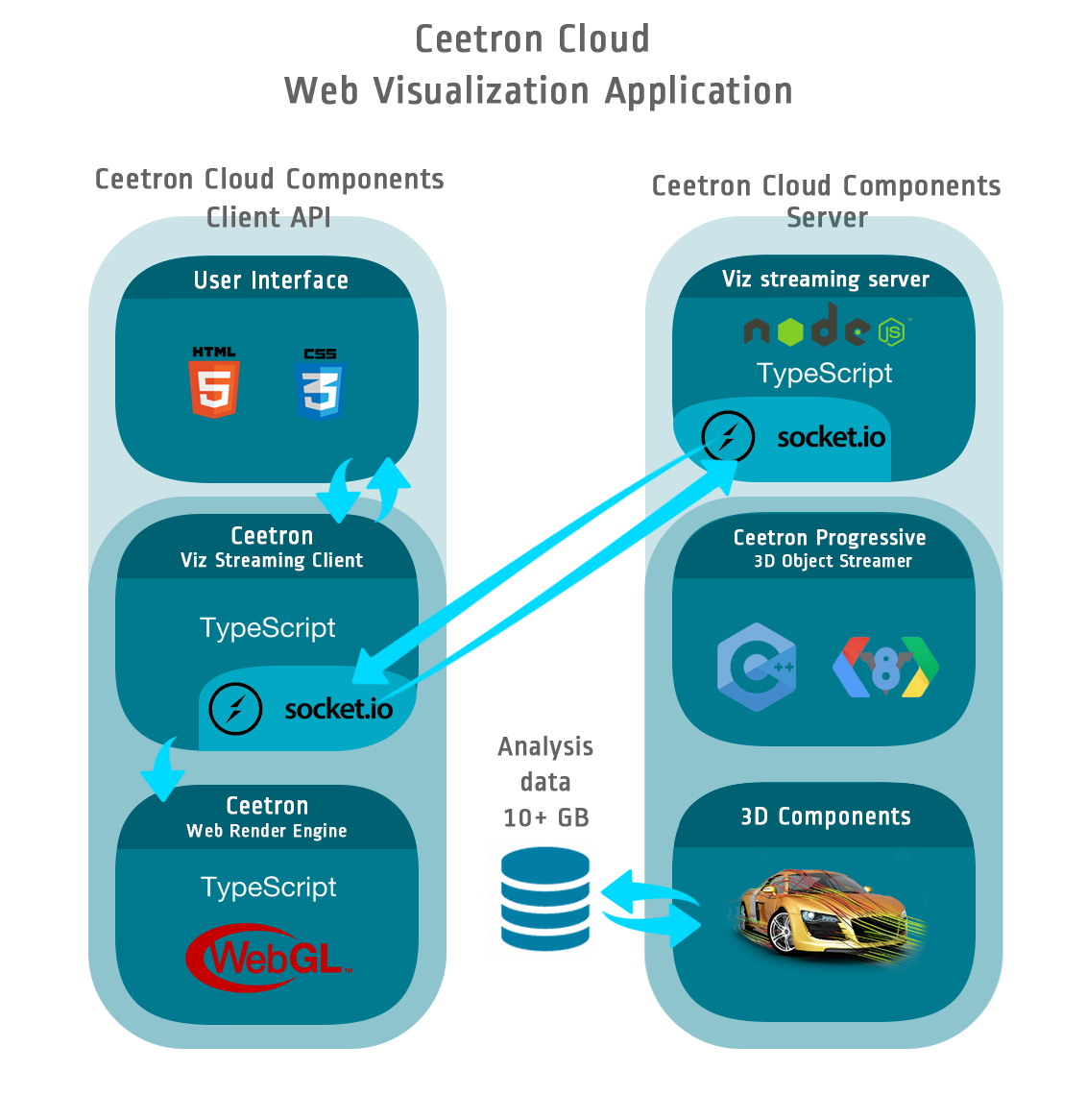By Grim Gjønnes*, Crisp Ideas AS
The cloudification of CAE applications is picking up speed. Established vendors like ANSYS, Autodesk and Dassault Systèmes Simulia, as well as newcomers such as Onshape, SimSolid and FIDESYS have recently announced new cloud-based offerings, or cloud-based extensions of their existing offerings. Last year Ceetron, the market leader in 3D visualization for CAE, released Ceetron Cloud, a Dropbox-like platform for storing, viewing, and collaborating on CAE models in the cloud

Fredrik Viken. CTO Ceetron
In an informal interview, Fredrik Viken, CTO of Ceetron, provided a sneak peek into the upcoming release of their Ceetron Cloud Components SDK, and Ceetron’s roadmap for its cloud-based offerings. He also shared his thoughts about where the CAE industry will be going over the next 3-6 years. Here is an edited transcript:
Q1: I understand that Ceetron will shortly release Ceetron Cloud Components. Tell us what this offering is, and how it has been architected.
Fredrik: Cloud Components is a client-server framework for developing 3D visualization applications for web and cloud environments. Cloud Components is built on top of 3D Components, Ceetron’s main development platform for visualization and post-processing of FEA and CFD results.
In Cloud Components, the server manages the complete simulation model. Da ta can either be read
ta can either be read
on demand by the built-in readers, or developers can interact with 3D components on the server as they would today in a desktop application. The Progressive 3D Streamer (a new add-on component to 3D Components) then creates a compacted 3D display representations of objects which are then streamed to the client for local rendering using WebGL (see infographic). This architecture gives an optimal load balance between the client and the server. The result is graphics performance close to that of a desktop application, and a vastly improved user experience.
Cloud Components will be offered as a client API and a ready-to-run server app. The user will build the UI and interface with Cloud Components through the client API. The Client API lets the developer access all the features of 3D Components from a well-designed TypeScript/JavaScript API.
Cloud Components incorporates Progressive 3D Object Streaming, Ceetron’s latest technology for cloud-based 3D visualization. In a recent blog article (https://blog.ceetron.com/2016/01/21/visualization-in-the-cloud-for-cae-a-tale-of-two-architectures/), I provided some technical background for this approach to getting desktop performance in the cloud.
Q2: When are the beta release and GA release scheduled?
Fredrik: The beta release is 3 June 2016. The GA release is scheduled for September 2016.
Q3: Will Ceetron 3D Components continue to be marketed as a separate offering, or will 3D Components and Cloud Components merge, becoming the same thing?
Fredrik: Ceetron 3D Components will continue to be marketed as a separate offering for desktop developers and for advanced cloud application developers. Cloud Components is really an extension to this framework, adding the possibility to stream the display model to a web based client and to control the server from a JavaScript client in a web browser. Most of the features of 3D Components are exposed, and as we continue improving 3D Components with new features and increased performance, this will then also improve the Cloud Components. Most users will not have to interact directly with the 3D Components on the server (apart from making the data available through a custom file reader (if needed)), but all the power is there if needed for more specialized applications.
Q4: How will data flow from a CFD or FEA simulation engine in the cloud to a post-processor built on Cloud Components?
Fredrik: The user data will typically reside in a native CAE solver database format on a cloud-based server. The server part of the post-processor will read the native database on-demand directly into memory. The server will then organize the data, create a 3D display model, and immediately start streaming 3D objects to the local client. The CAE model will be streamed first in a coarse resolution that get progressively finer. The user can start interacting with the model as soon as the first elements are received by the web client.
Q5: Do you have any customers on this platform yet, or is it too early?
Fredrik: We have a beta program in place with a limited number of customers, both new and existing. Some existing customers have contributed to the specification phase of the development work.
Q6: What specific market need does Cloud Components address? What kind of customers do you foresee for this product?
Fredrik: Many CAE software vendors already have a cloud offering in place or are in the process of building one. Until now, most have had a big challenge making these solutions both user friendly and performant. They either used a server-based image rendering strategy, or had to download the data set to a local workstation for post-processing. This is not optimal for users, so we see an opening for our technology. Quite a few new players in CAE are going directly towards a cloud-based offering. The benefits of Ceetron Cloud Components for these newcomers are clear.
Q7: By the way, what happened with Ceetron Cloud, which was released last autumn? It seems to have somewhat disappeared from the news.
Fredrik: Ceetron Cloud is continually evolving, incorporating the latest elements of progressive 3D object streaming technology. After a somewhat slow start, we are pleased to see an increasing use of the Ceetron Cloud, and we expect more usage as awareness of Ceetron Cloud increases in the CAE community. It’s not unusual that it takes some time to convince IT professionals that using a new commercial cloud-based infrastructure is as secure as an in-house cloud solution.
Q8: And then we have 3D Viewer Pro for Cloud, which I understand will also be released as a Technical Preview in June. Could you explain why there is a market for a new general post-processor, cloud-based or not, and why Ceetron decided to create 3D Viewer Pro for Cloud?
Fredrik: A cloud-based post-processor, 3D Viewer Pro for Cloud will demonstrate a wide range of Cloud Components’ functionality. Having said that, the source code of the post-processor (the GUI and client source code) will also be offered as a starting point for developers who’d like a flying start in app development with Cloud Components. We don’t yet know if it will become a commercial offering. The main focus now is to showcase Cloud Components and offer our customers and evaluators a starting point and inspiration for how to create their own cloud offering.
Q9: 3D Viewer Pro for Cloud appears also to be an internal competitor to GLview Inova, Ceetron’s long-time workhorse for the CAE end user community. What will happen with GLview Inova, will they be merged or will they be kept as separate offerings?
Fredrik: GLview Inova will be kept as a separate offering in the future. There is currently no plan to merge GLview Inova with the new cloud-based post-processor.
Q10: Why would Ceetron release an end user product like 3D Viewer Pro for Cloud? I thought Ceetron has made a strategic decision to focus on the OEM market?
Fredrik: That is correct, and this is also the reason why we would consider thoroughly before releasing a cloud-based post-processor for the end user market.
Q11: Most of the recent announcements from the major CAE vendors seem to explicitly refer to AWS as a cloud platform. Will there also be space for MS Azure and Google Cloud in CAE space? Will Ceetron be able to support players basing their offerings on MS Azure or Google Cloud?
Fredrik: Cloud Components will support MS Azure and Google Cloud in addition to AWS. One of the really cool things about Cloud Components is that it puts very low requirements on the server infrastructure. Take the graphics: There are no requirements for graphics capabilities on the server, as rendering is being made locally on the client. If the server offers node.js and socket.io you are good to go.
Q12: Could you share with us Ceetron’s longer-term roadmap for its 3D visualization offerings, say 2017 and beyond?
Fredrik: Our desktop technology has reached a high maturity level and a large customer base. For 2016/2017 our core development efforts will go in two directions: One is to improve the technology behind the Cloud Components platform, to increase performance for end users and coding productivity for developers. The other direction is to develop add-on components to expand the use of the cloud technology in new directions. As an example, we are considering the use of Ceetron Cloud in combination with CAE report generation.
Q13: And now the crux of the matter: Will major CAE vendors continue to deliver desktop-based CAE applications over say the next 3-6 years? Will any newcomer to the CAE industry build its offering as a desktop application?
Fredrik: This is a complex one, but my answer is yes: the major CAE vendors will still have desktop offerings in 3-6 years from now. Ceetron strongly believe that all major CAE players will have offerings for the cloud in the next 3-5 years, but experience suggests that the transition from desktop to the cloud will take more time than expected. As for newcomers, I don’t think they’ll bother with desktop solutions; they will go ‘cloud only’.
Thanks to Fredrik. He can be reached at fredrik.viken@ceetron.com, for comments and follow-ups.
Grim Gjønnes
*) DISCLOSURE: I have and have had ongoing consulting engagements for Ceetron.







Leave A Comment
You must be logged in to post a comment.